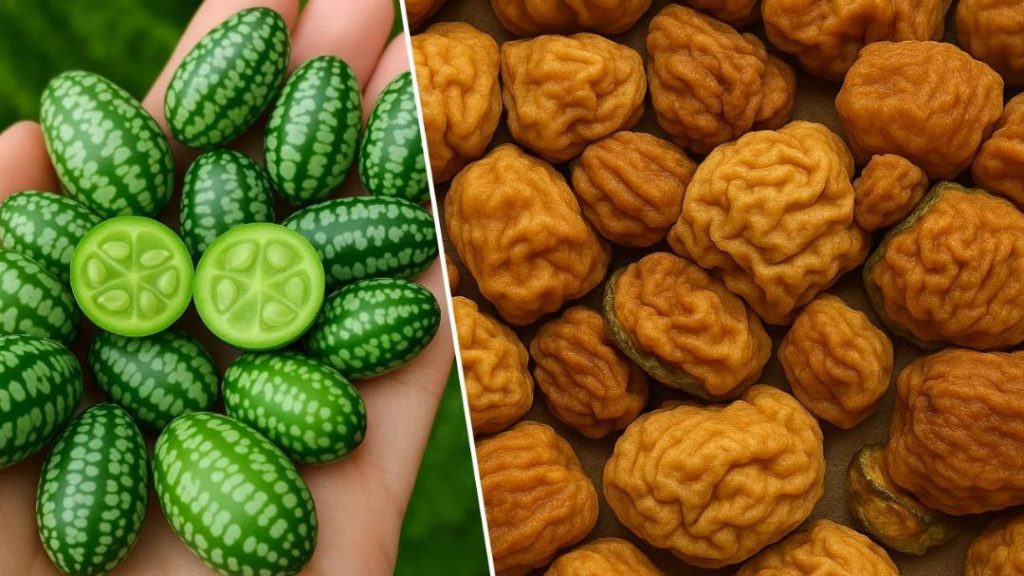
Did you know about Kachri, Rajasthan’s desert melon?
When we think of melons, we often picture juicy, sweet, and refreshing fruits that are perfect for hot summer days. However, there’s a lesser-known melon variety that’s gaining popularity in the culinary world, particularly in Rajasthan, India. Meet Kachri, a small, flavorful melon from the Cucurbitaceae family that’s been a staple in traditional Rajasthani cuisine for centuries.
Kachri, also known as the “desert melon,” is a small, oval-shaped fruit that measures about 5-7 cm in length and 3-5 cm in width. Its exterior is covered in a soft, green skin with a slightly ribbed texture, while the interior is divided into several segments filled with a tangy-sweet pulp. When ripe, the pulp is a deep yellow or orange color and has a unique flavor that’s both sweet and slightly sour.
Culinary Delights
Kachri is an essential ingredient in many traditional Rajasthani dishes, particularly in the summer months when its sweetness is at its peak. The fruit is often used in salads, raitas, and chutneys, where its tangy flavor adds a burst of freshness to the dish. In some regions, kachri is also used to make a sweet and sour sauce that’s served with snacks or as a side dish.
One of the most popular ways to enjoy kachri is in a traditional Rajasthani dish called “Kachri ki Sabzi.” This simple yet flavorful dish is made by sautéing the kachri pulp with onions, garlic, and spices, and then serving it with roti or paratha. The sweetness of the kachri pairs perfectly with the spices, creating a dish that’s both comforting and delicious.
Nutritional Benefits
Beyond its culinary appeal, kachri also boasts numerous nutritional benefits that have yet to be fully explored. The fruit is rich in vitamins A and C, potassium, and fiber, making it an excellent choice for those looking to boost their immune system and digestive health.
Kachri is also known to have anti-inflammatory properties, which can help to reduce inflammation in the body and alleviate symptoms of conditions such as arthritis. Additionally, the fruit has been found to have antioxidant properties, which can help to protect the body against free radicals and oxidative stress.
Cultivation and Growing Conditions
Kachri is a warm-season crop that thrives in the arid conditions of Rajasthan, where it’s typically grown in small plots or home gardens. The fruit is relatively easy to cultivate, as it requires minimal maintenance and can be grown in a variety of soil types.
Kachri plants are typically grown from seeds, which are sown in well-draining soil and watered regularly. The plants require full sun to partial shade and should be kept weed-free to prevent competition for nutrients.
Conservation Efforts
Despite its numerous benefits, kachri is a relatively unknown fruit outside of Rajasthan. In recent years, there has been a growing concern about the decline of traditional crops like kachri, which are often replaced by more commercially viable crops.
To address this issue, conservation efforts are underway to promote the cultivation and consumption of kachri. The Indian government has launched initiatives to promote traditional crops like kachri, and many non-governmental organizations are working to educate farmers about the benefits of growing this unique fruit.
Conclusion
Kachri, Rajasthan’s desert melon, is a flavorful and nutritious fruit that’s been a staple in traditional Rajasthani cuisine for centuries. With its tangy-sweet pulp and numerous health benefits, it’s no wonder why kachri is so highly prized in this region.
As we continue to explore new and innovative ways to incorporate kachri into our diets, it’s essential that we also support conservation efforts to protect this unique fruit and its cultivation practices. By doing so, we can ensure that future generations can continue to enjoy the flavors and benefits of kachri for years to come.
Source:






